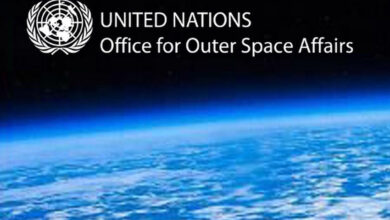The Indian Space Policy 2023 is aimed at providing significant boost to the Indian Space economy
- The Indian Space Policy of 2023 is more than just a document for the civilian space program.
- The Policy is described as a futuristic one that positions and launch the Indian Space Sector in the 21st century.
- The Indian Space Policy 2023 is a versatile and all-inclusive document that caters to the nation’s comprehensive scientific, security, environmental, economic, and cultural needs.
- Some of its major highlights include robust space reforms, a significant boost for private sector participation, and the expansion of space economy opportunities.
- India’s Union Cabinet, headed by Prime Minister Narendra Modi, granted approval for India’s new Space Policy, which aims to enhance the role of the Department of Space, increase operations of the Indian Space Research Organization (ISRO) missions, and foster greater engagement from academia, research institutions, unicorns, start-ups, and industries.
- Reports suggest that the country’s space economy is poised for major growth in the next five years.
- S. Somanath Chairman ISRO said India’s share in the global space economy was less than two per cent at present and the space policy will help it increase substantially to 10 per cent in the future.
Bangalore, June 13. India set the stage a few years back when it revealed its commitment to being a front-runner in the space arena.

Hence, the Indian Space Policy of 2023 is more than just a document for the civilian space program; it encompasses much more. With the new policy, India is eliminating the unnecessary segregation between military, civilian, and commercial end-users.
The ‘Vision’ is to “enable, encourage and develop a flourishing commercial presence in space” that suggests an acceptance that the private sector is a critical stakeholder in the entire value chain of the space economy.
New Delhi has taken action to blur the lines between these three sectors, as observed worldwide. The Indian Space Policy 2023 is a versatile and all-inclusive document that caters to the nation’s comprehensive scientific, security, environmental, economic, and cultural needs.
Some of its major highlights include robust space reforms, a significant boost for private sector participation, and the expansion of space economy opportunities. India’s Union Cabinet, headed by Prime Minister Narendra Modi, granted approval for India’s new Space Policy, which aims to enhance the role of the Department of Space, increase operations of the Indian Space Research Organization (ISRO) missions, and foster greater engagement from academia, research institutions, unicorns, start-ups, and industries.
The Indian Space Policy of 2023 will make Indian satellite data of over 5m open and freely accessible to all users.
For the past 40 years, ISRO has been collecting data through numerous satellites, which will now be available to everyone. ISRO’s remote sensing data, which is in high demand, will also be made freely accessible. Thematic data, along with other significant data, will also be made available for free. India aims to achieve sustained human presence in space and will undertake nuanced studies and missions to explore celestial prospects and the extra-terrestrial existence of humans.
As India currently holds the G20 Presidency, a planning meeting called the “G20-Chief Science Advisers Roundtable (G20-CSAR)” was held to discuss the agenda topics of the initiative.
This meeting, chaired by India’s Scientific Secretary, who is the Principal Scientific Adviser to the Government of India, involved officials from G20 countries who shared their ideas and suggestions on topics of mutual interest. G20-CSAR is a unique proposal conceptualized under India’s G20 Presidency, aiming to bring together the Head Science Advisors of G20 and other countries to develop a shared framework for addressing critical global science and technology policy issues.
India has made significant strides in the space sector in recent years, thanks to various initiatives from the government and private players.
Reports suggest that the country’s space economy is poised for major growth in the next five years. With the 2023 Indian Space Policy, the growth of the space sector in India appears promising.
The current estimate for the Indian space economy is slightly above $10 billion, and the country aims to achieve double-digit growth in the next five years.
India’s space economy currently represents at least 2 to 2.5% of the global space economy and is expected to grow to over 10% in the coming years.
In light of the ongoing Russia-Ukraine conflict, both SpaceX and ISRO have been considered for launches by OneWeb, with SpaceX’s Dragon and Falcon Heavy selected to carry several satellite payloads to Low Earth Orbit (LEO) this year.
With its 1,750 kg PSLV and 2,500 kg GSLV platforms, ISRO has already demonstrated its capability to successfully launch payloads into orbit and can now compete for clients who plan to move their business away from Russian agencies.
The ongoing war may bring about a significant shift in space transportation, and India may be more favourable than Russia, with clients opting for innovation over heritage.
The new space policy of India aims to foster greater private sector participation in the sector, with ISRO primarily focusing on research and development of advanced space technologies.
The private sector is expected to be highly involved in end-to-end space activities, including satellite manufacturing, rocket launches, launch vehicles, data collection, and dissemination.
Meanwhile, ISRO will concentrate on developing new technologies, systems, and engaging in intensive research and development.
To support these objectives, NewSpace India Limited (NSIL) will carry out strategic activities related to the space sector and operate in a demand-driven mode.
The Indian National Space Promotion and Authorization Centre (INSPACe) will serve as the interface between the Indian Space Research Organization and non-governmental entities.
The private sector will rely on ISRO for infrastructure while ISRO focuses on non-commercial scientific missions of greater complexity, such as shaping deep-space missions and launching Indians into space through Gaganyaan.
In a significant leap for India, private and foreign companies will participate in rocket and satellite launches.
Additionally, satellite data reception stations will be established, and INSpaCe will act as ISRO’s regulatory authority.
There is also considerable discussion surrounding the Department for Promotion of Industry & Internal Trade (DPIIT) in India. This department will play a role in shaping India’s new space policy, among other multifarious activities.
One of its tasks will be to streamline Foreign Direct Investment, and the government has devised modalities to attract substantial investments.
DPIIT will also focus on marketing products and technologies on a global scale. India claims that it is ISRO that discovered the presence of water molecules on Mars, while the US and China have their rovers exploring the planet.
Presently, EMISAT serves as a defence protector satellite, equipped with a payload that can access information about deep-sea ships, greatly benefiting India’s maritime operations.
Trivandrum’s Indian Institute of Space Science & Technology has developed a special payload for studying the layers of the atmosphere, particularly the ionosphere.
Another notable development is ASAT, an Anti-satellite missile resulting from a joint collaboration between the Defence Research & Development Organization and ISRO.
This satellite enables India to destroy enemy satellites, including micro ones, within a short timeframe. When enemy satellites attempt to gather information, they can be promptly identified and destroyed.
Previously, only the USA, Russia, and China possessed this capability. In pursuit of military objectives, India created and developed ‘Mission Shakti.’ Indian satellites also detect and study deep-sea information, providing a significant strategic advantage, and aid in studying various atmospheric characteristics.
Indian satellites also benefit common people, such as farmers who receive alerts about sudden rainfall and climate changes. In modern agriculture, the satellites help study soil parameters and determine the appropriate level of irrigation for different soil types.
India aims to bring its space technologies to the grassroots level, with an emphasis on effective water tracking systems.
The India-US joint venture NISAR represents a brilliant step in this direction.
India is diligently working to race ahead in its space development initiatives, with round-the-clock research and development activities.
The Launch Vehicle Mark-III (LVM3) is yet another step in this direction. Collaborations in space and technological disruptions will be major focal points in the coming years, and it seems that India, with its newfound resolve, is well-prepared to leave its mark on other planets as well, as mentioned in its ‘Made in India’ manifesto for space exploration.





